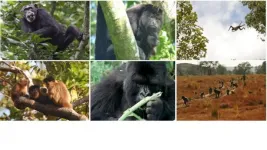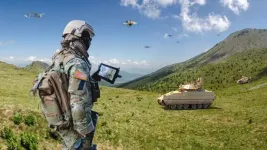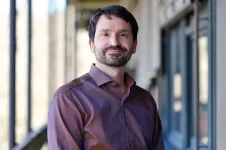INFORMATION:
Travel paths of primates show how their minds work
How primates get from A to B gives vital information about their cognitive evolution, say researchers in a new study looking at the travel paths of animals in the wild.
2021-04-23
(Press-News.org) How primates get from A to B gives vital information about their cognitive evolution, say researchers in a new study looking at the travel paths of animals in the wild. Using data from 164 wild primate populations, the global survey examines the mental abilities that primates, including ourselves, use to know where and when to travel in the most efficient way.
A birds eye view
Co-author Miguel de Guinea, expert in Evolutionary Anthropology at Oxford Brookes University commented: "Imagine looking down on a huge outdoor market from high in the sky, perhaps from a drone hovering quietly above. The people below move in different ways. Some wander haphazardly among the stalls: they are learning what's available but are clearly not busy. Others take bee-line routes across the market to a destination they obviously wanted to reach, then, after buying what they need, head back in much the same way.
"If you could distinguish individuals, and watch them on many occasions, these patterns are likely to change, sometimes dependent on fruit and vegetables in season. We would also begin to learn about social aspects, as networks of repeated contacts show who is friendly with whom. We can get a good idea of people's knowledge, their needs, their ability to think ahead and how they learn over time - just from watching their travel paths. The same observations have been made by the research team using data from GPS devices and in-field studies of wild primates, giving us fascinating information about their development."
Travel decision-making adds to picture
The original data was gathered from small GPS devices, used routinely in primate fieldwork: sometimes these are attached to the animals themselves, but in many studies a researcher follows the animals, usually noting a rich variety of background information on what they are doing and for how long.
The international team developed a conceptual framework to highlight ways in which these data can be analysed. Currently, primate cognition is studied by comparing measures such as brain size, or conducting experiments with artificial problems to primates in captivity. The evidence from travel decision-making amongst wild populations will enhance these approaches and give a fuller picture of the cognitive development of these species.
An urgent vision for primate research
Lead-author Karline Janmaat from the University of Amsterdam said: "Our ultimate dream is to set up a consortium to support data sharing and collaboration among primatologists. Hopefully this attracts MSc and PhD students from around the world to share and compare their collected data to these existing datasets."
The researchers say that further research is urgent, because so many species are now threatened with extinction in the wild. Since 1970, two-thirds of all vertebrate populations have been lost, and large, day-living animals like primates have been significantly impacted.
Miguel de Guinea stressed: "Time is fast running out - if we don't act now we may never be able to understand the drivers of cognitive evolution. By applying our research methodology and findings we can make use of previously collected valuable data from wild populations and apply that to our understanding of the cognitive evolution of primate species."
The research Using natural travel paths to infer and compare primate cognition in the wild is published in iScience.
ELSE PRESS RELEASES FROM THIS DATE:
Hubble captures giant star on the edge of destruction
2021-04-23
In celebration of the 31st anniversary of the launching of NASA's Hubble Space Telescope, astronomers aimed the renowned observatory at a brilliant "celebrity star," one of the brightest stars seen in our galaxy, surrounded by a glowing halo of gas and dust.
The price for the monster star's opulence is "living on the edge." The star, called AG Carinae, is waging a tug-of-war between gravity and radiation to avoid self-destruction.
The expanding shell of gas and dust that surrounds the star is about five light-years wide, which equals the distance from here to the nearest star beyond the Sun, Proxima Centauri.
The huge ...
New data could inform youth-focused pandemic messaging
2021-04-23
Now that teens and young adults across the country account for an increasing share of COVID-19 cases, and many have become eligible for vaccination, several recently published studies based on polls of this age group provide insights into the kinds of messaging that might work best for both preventing transmission and vaccine uptake.
Using data from text-message polls of people between the ages of 14 and 24 taken at several points in 2020, researchers from the University of Michigan find a clear theme: that most young people are taking COVID-19 seriously and trying to follow public health guidance, and that many of them they are motivated by the desire to protect ...
Army, ASU publish human-autonomy communication tips
2021-04-23
ABERDEEN PROVING GROUND, Md. -- Army and Arizona State University researchers identified a set of approaches to help scientists assess how well autonomous systems and humans communicate.
These approaches build on transformational scientific research efforts led by the Army's Robotics Collaborative Technology Alliance, which evolved the state of robots from tools to teammates and laid the foundation for much of the service's existing research into how humans and robots can work together effectively.
As ideas for autonomous systems evolve, and the possibilities ...
Critical understanding of why and how solid-state batteries
2021-04-23
Researchers from the Faraday Institution's SOLBAT project have made a significant step in understanding how and why solid-state batteries (SSBs) fail. A paper, published in Nature Materials on 22 April, provides answers to one important piece of the scientific puzzle.
To make step changes in electric vehicle (EV) battery range and safety at a lower cost, new battery chemistries that are "beyond lithium ion" must be developed. SSBs are one such promising technology, but mass market adoption has been held back by several key technical challenges that cause the battery to fail when charged and discharged.
SSBs can short circuit after repeating charging and discharging. One well-recognised cause of battery failure is the growth of dendrites, branching networks of lithium that ...
First description of a new octopus species without using a scalpel
2021-04-23
An evolutionary biologist from the University of Bonn brought a new octopus species to light from depths of more than 4,000 meters in the North Pacific Ocean. The sensational discovery made waves in the media a few years ago. Researchers in Bonn have now published the species description and named the animal "Emperor dumbo" (Grimpoteuthis imperator). Just as unusual as the organism is the researchers' approach: in order to describe the new species, they did not dissect the rare creature, but instead used non-destructive imaging techniques. The results have now been published in the prestigious journal BMC Biology.
In the summer of 2016, Dr. Alexander ...
Climate change impacts conservation sites across the Americas
2021-04-23
A continental-scale network of conservation sites is likely to remain effective under future climate change scenarios, despite a predicted shift in key species distributions.
New research, led by Durham University and published in the journal Frontiers in Ecology and Evolution, investigates the impacts of potential climate change scenarios on the network of Important Bird and Biodiversity Areas (IBAs) across the Caribbean, and Central and South America.
The research was carried out in collaboration with Senckenberg Biodiversity and Climate Research Centre, BirdLife International and the National Audubon Society.
IBAs are sites identified as being internationally important for the conservation of bird populations, with over 13,000 ...
Researchers uncover activation mechanism of a cell growth protein that can trigger cancer
2021-04-23
There are many different types of cancer, but they all have one thing in common: errors in the signals that control normal cell behaviour can cause uncontrolled cell growth and cell division, leading to a tumour. An enzyme called SHP2 plays a key role in this regard. SHP2 is a signalling molecule that in its activated state stimulates cell proliferation. In a normal healthy body, the rates of cell proliferation and cell death are balanced and tumours do not develop. However, if SHP2 becomes too active, the number of cells being created outweighs the number that die, which can lead to the formation of dangerous tumours. Enhanced SHP2 activity resulting from genetic ...
Fight or flight response may hinge on protein in skeletal muscular system
2021-04-23
Researchers at the University of Cincinnati say a regulatory protein found in skeletal muscle fiber may play an important role in the body's fight or flight response when encountering stressful situations.
The protein, fast skeletal myosin binding protein-C (fMyBP-C), plays a foundational role in the proper regulation of contractile structure and function in the body's fast twitch muscles -- these muscles produce sudden bursts of power to sprint into action, jump or lift heavy objects. Fast skeletal myosin binding protein-C modulates the speed and force of fast skeletal muscle contraction.
"This response ...
Muscle gene linked to type 2 diabetes
2021-04-23
People with type 2 diabetes tend to have poorer muscle function than others. Now a research team at Lund University in Sweden has discovered that in type 2 diabetes, a specific gene is of great importance for the ability of muscle stem cells to create new mature muscle cells. The findings are published in Nature Communications.
"In people with type 2 diabetes, the VPS39 gene is significantly less active in the muscle cells than it is in other people, and the stem cells with less activity of the gene do not form new muscle cells to the same degree. The gene is important when muscle cells absorb sugar from blood and build new muscle. Our study is the first ever to link this gene to type 2 diabetes", says Charlotte Ling, professor of epigenetics at Lund University who led ...
'Planar and curved' pyrrole-fused azacoronenes
2021-04-23
Recently study on synthetic approaches toward polycyclic aromatic hydrocarbons (PAHs) as graphene with a well-defined structure has attracted much attention. A research group in Ehime University has been studying the synthesis and fundamental properties of pyrrole-fused azacoronene (HPHAC), a nitrogen-containing PAH. HPHACs are composed of electron-rich pyrroles, which are easily oxidized, and their dicationic species in particular exhibit unique features such as global aromaticity based on macrocyclic π-conjugation. However, all the compounds reported so far have bulky ...
LAST 30 PRESS RELEASES:
Numbers in our sights affect how we perceive space
SIMJ announces global collaborative book project in commemoration of its 75th anniversary
Air pollution exposure and birth weight
Obstructive sleep apnea risk and mental health conditions among older adults
How talking slows eye movements behind the wheel
The Ceramic Society of Japan’s Oxoate Ceramics Research Association launches new international book project
Heart-brain connection: international study reveals the role of the vagus nerve in keeping the heart young
Researchers identify Rb1 as a predictive biomarker for a new therapeutic strategy in some breast cancers
Survey reveals ethical gaps slowing AI adoption in pediatric surgery
Stimulant ADHD medications work differently than thought
AI overestimates how smart people are, according to HSE economists
HSE researchers create genome-wide map of quadruplexes
Scientists boost cell "powerhouses" to burn more calories
Automatic label checking: The missing step in making reliable medical AI
Low daily alcohol intake linked to 50% heightened mouth cancer risk in India
American Meteorological Society announces Rick Spinrad as 2026 President-Elect
Biomass-based carbon capture spotlighted in newly released global climate webinar recording
Illuminating invisible nano pollutants: advanced bioimaging tracks the full journey of emerging nanoscale contaminants in living systems
How does age affect recovery from spinal cord injury?
Novel AI tool offers prognosis for patients with head and neck cancer
Fathers’ microplastic exposure tied to their children’s metabolic problems
Research validates laboratory model for studying high-grade serous ovarian cancer
SIR 2026 delivers transformative breakthroughs in minimally invasive medicine to improve patient care
Stem Cell Reports most downloaded papers of 2025 highlight the breadth and impact of stem cell research
Oxford-led study estimates NHS spends around 3% of its primary and secondary care budget on the health impacts of heat and cold in England
A researcher’s long quest leads to a smart composite breakthrough
Urban wild bees act as “microbial sensors” of city health.
New study finds where you live affects recovery after a hip fracture
Forecasting the impact of fully automated vehicle adoption on US road traffic injuries
Alcohol-related hospitalizations from 2016 to 2022
[Press-News.org] Travel paths of primates show how their minds workHow primates get from A to B gives vital information about their cognitive evolution, say researchers in a new study looking at the travel paths of animals in the wild.







